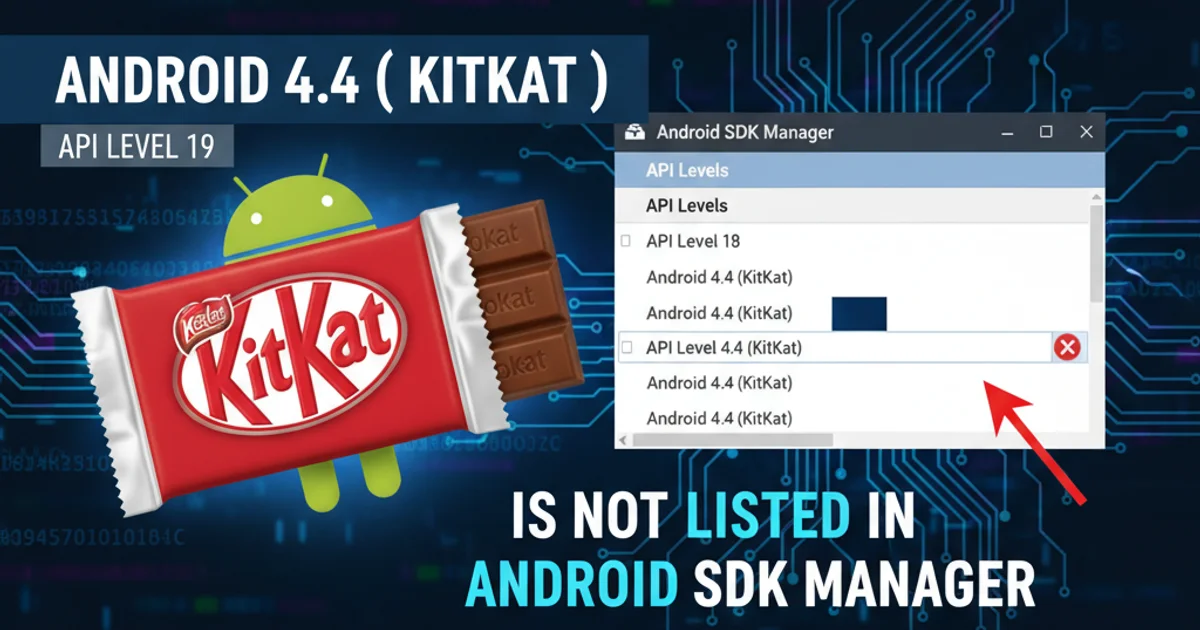Android 4.4 ( KITKAT ) API LEVEL 19 is not listed in Android SDK Manager
Categories:
Resolving Missing Android 4.4 (KitKat) in SDK Manager

Learn how to troubleshoot and resolve issues when Android 4.4 (API Level 19) is not appearing in your Android SDK Manager, preventing you from developing for KitKat devices.
Many Android developers occasionally encounter situations where specific API levels or SDK components are not listed in the Android SDK Manager, even after refreshing. A common instance of this has been with Android 4.4 (KitKat), API Level 19. This article will guide you through the common causes and solutions for this problem, ensuring you can access and install the necessary SDK components for your development needs.
Understanding the SDK Manager and its Updates
The Android SDK Manager is a crucial tool for managing your development environment. It allows you to download and install various SDK platforms, build tools, system images, and other components required for Android development. The list of available packages is fetched from Google's servers. If this list isn't updated correctly, or if there are network issues, certain packages might not appear.
flowchart TD
A[Start SDK Manager] --> B{Fetch Package List from Google};
B -->|Success| C[Display Available Packages];
B -->|Failure/Incomplete| D[Missing Packages (e.g., API 19)];
D --> E{Troubleshoot Network/Proxy};
E --> F{Force Refresh/Clear Cache};
F --> G[Re-attempt Fetch];
G -->|Success| C;
G -->|Failure| H[Manual SDK Installation/Verification];Flowchart of SDK Manager package fetching and troubleshooting.
Common Causes for Missing API Levels
Several factors can prevent an API level from showing up in the SDK Manager:
- Outdated SDK Manager: The SDK Manager itself might be outdated and unable to correctly fetch the latest package lists.
- Network or Proxy Issues: Firewalls, proxy settings, or general network connectivity problems can block the SDK Manager from reaching Google's update servers.
- Corrupted Cache: The SDK Manager maintains a cache of available packages. A corrupted cache can lead to an incomplete list.
- Incorrect Repository Settings: While less common for standard API levels, custom repository settings could interfere.
- Eclipse ADT Plugin Issues: If you're using an older Eclipse ADT setup, the plugin itself might be causing display problems.
Solutions to Make API Level 19 Appear
Here are the steps you can take to resolve the issue of Android 4.4 (API Level 19) not being listed:
1. Update the Android SDK Tools
Open your Android SDK Manager. Ensure that 'Android SDK Tools' and 'Android SDK Platform-tools' are updated to their latest versions. Sometimes, updating these core components refreshes the available package list.
2. Force Refresh and Clear Cache
In the SDK Manager, go to 'Tools' -> 'Options...'. In the 'Android SDK Manager - Settings' dialog, you might find an option to 'Clear Cache'. After clearing, try 'Packages' -> 'Reload' or simply close and reopen the SDK Manager. For older versions, you might need to manually delete the temp folder within your SDK directory.
3. Adjust Proxy Settings
If you are behind a corporate firewall or proxy, configure the proxy settings in the SDK Manager. Go to 'Tools' -> 'Options...' and enter your HTTP Proxy Server and HTTP Proxy Port. You might also need to check 'Force https://... sources to be fetched using http://...' if you encounter SSL certificate issues.
4. Check Network Connectivity
Verify that your internet connection is stable and that there are no firewalls or antivirus programs blocking the SDK Manager's access to dl.google.com or dl-ssl.google.com.
5. Use the Command Line (for advanced users)
If the GUI SDK Manager is still problematic, you can try listing and installing packages via the command line. Navigate to your SDK's tools/bin directory (or tools for older SDKs) and use sdkmanager --list to see available packages and sdkmanager "platforms;android-19" to install it. For older SDKs, use android list sdk and android update sdk --no-ui --filter platform-tools,android-19.
6. Verify Eclipse ADT Plugin (if applicable)
If you are using Eclipse with the ADT plugin, ensure your ADT plugin is updated. Go to 'Help' -> 'Check for Updates' in Eclipse. Sometimes, an outdated ADT plugin can cause display issues within the SDK Manager integrated into Eclipse.
# For newer SDKs (Android Studio era):
# List available packages
sdkmanager --list
# Install Android 4.4 (API Level 19) platform
sdkmanager "platforms;android-19"
# For older SDKs (Eclipse ADT era):
# List available packages
android list sdk
# Install Android 4.4 (API Level 19) platform and platform-tools
android update sdk --no-ui --filter platform-tools,android-19
Command-line examples for managing Android SDK packages.